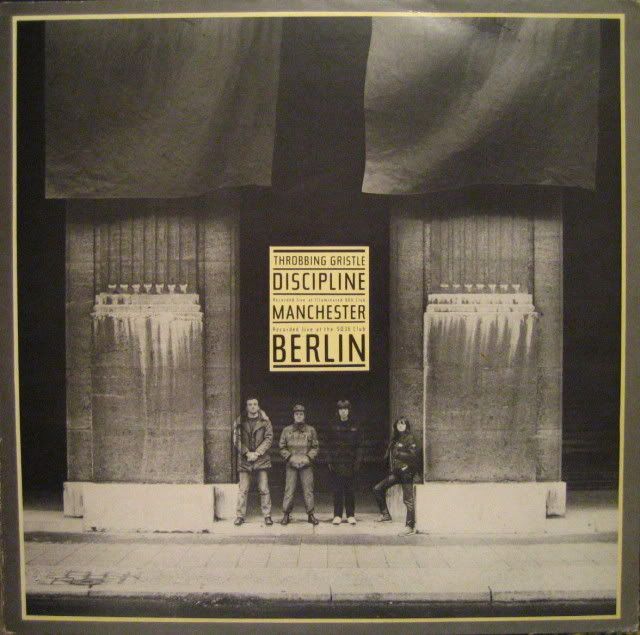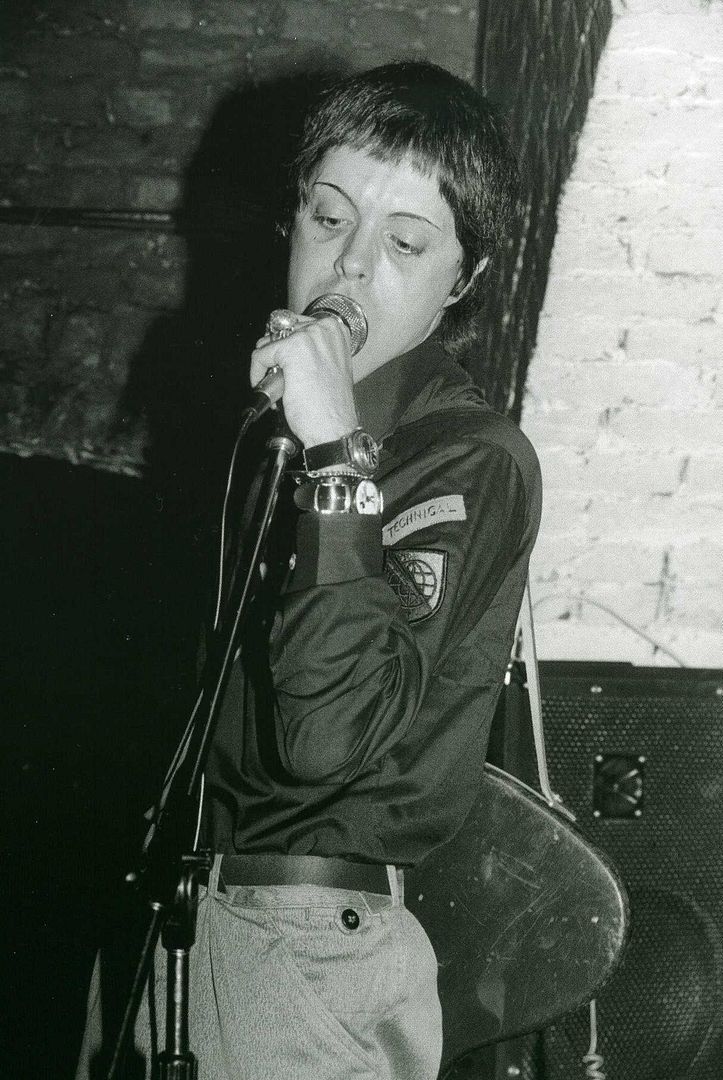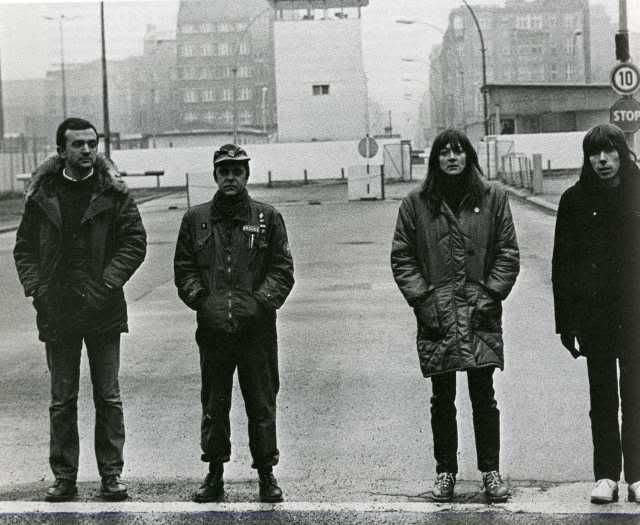

Discipline SO36 Club Berlin 07/11/80
Discipline 666 Club Manchester 04/12/80
Industrial disco hit released to the world via Fetish Records in 1981 – marching music for psychic youth indeed, two shots of the same track recorded at Berlin and Manchester at the end of 1980. Text below written by Pete and ripped ungraciously from mute.com.

Like their mid 1970’s contemporaries, The Sex Pistols, Throbbing Gristle exploded into being amidst a blitz of controversy and banner headlines. Convention, it seemed was running for cover in the face of their all out attack. But whilst punk’s campaign to shock the music industry that spawned it lasted but a few hectic years, Throbbing Gristle’s assault took the form of a sustained approach that was a much more calculated affair.Throbbing Gristle (Northern slang for an erection) was officially born in 1976 primarily to provide sonic support to the Hull based Coum Transmissions, a performance art collective formed by Genesis P-Orridge with his then partner Cosey Fanni Tutti. By the time of their infamous exhibition Prostitution, at London’s ICA in October 1976, Coum had largely succeeded in it’s aim of confronting and confounding all expectations within the visual arts and were seeking a new target for their actions. The addition of Peter ‘Sleazy’ Christopherson, a young graphic designer with a passion for all things perverse and Chris Carter an electronics enthusiast capable of building his own synthesizers and keyboards, provided the requisite personnel to create the traditional number of ‘a band’. As a quartet TG were then fully equipped to begin a methodical deconstruction of their next target…..the music business.
First came their reinvention of the live rock show with Genesis and Cosey bringing their art gallery honed presentation and audience confrontation skills, to the traditional format of ‘the gig’. If rock concerts were ultimately performances by recognisable rock groups using the show to promote material that they currently had available as albums and singles, then Throbbing Gristle’s early live shows were a very different affair. Back then there was certainly no product to shift so TG used this platform to educate, inform and subert instead, The live sound of TG in full flow was often characterised by improvised banks of blank electronic sound emanating from equipment that Chris and Sleazy had built in order to generate the loudest noises possible. Their kit was augmented by tape machines, mistreated violins, cornets and the cheapest lead and bass guitars on the market, with the whole lot then fed through varying amounts of processing effects and mixed live from the stage. Genesis often became a parody of the recognisable rock front man, adding vocals which when they weren’t resembling primal scream therapy, sounded like direct threats to the audience or weedy, reedy little songs about news stories, sex, violence and things that just came into his head at any given moment. Later TG live shows often reworked the Coum Transmissions concept of challenging the relationship between the performer and the audience to create new levels of extremity. For some performances, blinding Halogen lamps were pointed at the crowd at others strobes flashed constantly and a huge wall of mirrors at the rear of the stage forced the audience to confront themselves. Films often played an important role too and it was not unusual for medical operation footage or hardcore sex loops to feature in the performance. In this state of confusion Genesis sometimes succeeded in provoking the crowd into action. TG’s audiences went wild attacking, each other, the band or the building they were in as some kind of cathartic release from what they were experiencing. The extremity of every aspect of a live TG show meant that their own epithet ‘Entertainment Through Pain’ probably remains the best description of these unique events.

The next step in their media barrage saw TG turn their attentions to the creation of a record label and Industrial Records was established in 1977 at the Martello Street art space where Cosey and Genesis rehearsed. This suitably bleak and unglamorous part of Hackney, London gave Throbbing Gristle an HQ from which to mass-produce their records as an extension of their manifesto and as if they really were an industrial commodity, like cars.
In November 1977, Industrial Records released TG’s debut album, The Second Annual Report Of Throbbing Gristle in a plain cardboard sleeve that represented the polar opposite of the lavish gatefold artwork which major record companies were commissioning at the time. Similarly far removed from the lavish excess of progressive rock whimsy, the records title alluded to the boredom of business documents and government departments. Rather than far off worlds and places, this record seemed to represent the colder realities of the times that had produced it. Hidden inside this plain sleeve was a sticker that proclaimed’ ‘NOTHING SHORT OF TOTAL WAR’, and another which featured a lightning flash that was to become TG’s logo. Despite it’s vaguely fascistic connotations it was said to represent “the short-circuiting of control”. For the Industrial Records logo, a cold black and white image of the ovens at Auschwitz was reproduced and another slogan announced that it was ‘MUSIC FROM THE DEATH FACTORY’ prompting outrage from some and deep discussion about our relationship with such imagery in others. On the record itself Throbbing Gristle’s subversive wit is everywhere. Standard record industry procedure at the time was to develop artists over a course of singles and LPs until the release of a ‘live in concert’ album featuring versions of tracks their audience had come to know and love. TG turned this practice nicely on it’s head by choosing to make one side of their first official release a selection of primitive and extremely rough live recordings of just two tracks, “Slug Bait” and “Maggot Death”. The second side of the LP being completely given over to a live improvised piece that had been the soundtrack to Coum Transmissions film “After Cease To Exist”.
Side one of The Second Annual Report Of Throbbing Gristle was recorded using a cheap cassette recorder with a condenser microphone, a technique that was somehow perfect for capturing the rawness of their sound but one that was certainly at odds with major record companies’ struggle for greater quality and listener immersion at the time. This technique compliments TG’s live sound perfectly with even it’s digital journey onto CD not distracting from the power of this sound. Side two is more professionally presented having been mastered on a reel to reel. Few who have chanced across this record with it’s peculiar presentation and totally intriguing sonic content, have ever forgotten it or failed to be intrigued by the improvisational techniques through which it came to be made. This record did not just launch a new sound; it launched a whole genre of music that travelled the world and that rather fittingly came to be known as Industrial.
Wisdom had it that every record company must release a single to promote an album, and Industrial Records were no different in this respect, except for the fact that their single featured two ‘tracks called United and Zyklon B Zombie and neither track had been featured on an LP. Wrapped in a sleeve that saw a development of Industrial’s cheap yet highly effective black and white aesthetic United/”Zyklon B Zombie was a swipe at all that conventional pop music was meant to be. A primitive electro-pop backing and cheap drum machine supports a cross between a bored love song and something from the football terraces. Still courting controversy Zyklon B Zombie takes the first part of it’s name from the gas used in the concentration camps and is a nosily thrashed counterpoint to the whimsy of the stab at pop music on the other side.
Throbbing Gristle’s playful record industry parody was taken to new heights with next Industria Records release, 1978’s D.O.A The Third And Final Report Of Throbbing Gristle. At the time it was possible to take a record to the counter or listening booth of a record shop and have it played, the assistant usually choosing the first track on side one as best way to lead the listener in. TG realised this and opened D.O.A The Third And Final Report Of Throbbing Gristle with I.B.M a series of bleeps and tones from a found cassette tape that had been sent to them. The logic here was that if the listener could cope with track one side one, the rest of this extremely diverse and challenging LP would definitely appeal to them! TG’s love of parody and deconstruction is at it’s most wilful on this record. Progressive rock superstars at the time had taken to recording solo albums as “personal projects…man” and Throbbing Gristle certainly did not want to miss out on this trick. Each member reveals their own aural pleasures in a selection of solo compositions that help mark DOA as TG’s most varied release and one that ultimately flies in the face of the critics who had dismissed TG as purveyors of the monotonous dirge. Chris Carter delivers the amazing AB/7A a timeless piece of superbly crafted synth pop with more than a touch of Krautrock about it. Peter ‘Sleazy’ Christopherson opts for using disturbingly hypnotic found sounds on Valley Of The Shadow Of Death”, where as Cosey Fanni Tutti’s Hometime captures the contentment of kids innocently playing at the end of a day. Genesis P-Orridge brings his track Weeping, a haunting work that sounds like it’s title through the use of four violins and a space echo to achieve it. Industrial, almost realising the error of their ways chose to include the single United’ on ‘D.O.A’, except that it is recorded from a tape running so quickly that it is reduced to a few squeaky seconds of record time!

Despite 1978 bringing unexpected artistic and a somewhat against the odds commercial success, personal relationships within TG were not in good shape. Cosey Fanni Tutti’s long-term relationship with Genesis P-Orridge ended and she began a new one with Chris Carter. Luckily for music lovers everywhere TG continued with it’s quest to subvert all that they surveyed and by 1979 Industrial Records and Throbbing Gristle had even healthier record sales and a burgeoning international fanbase. With so many people hungry for a slice of Gristle, Industrial Records established their own take on the fan clubs that were so popular with UK teens at the time. Promotional materials became marvellous parodies of conventional record company artist photographs and the group produced truly ironic merchandise. TGHQGB as the office at Martello St came to be known, began to issue Industrial News, a newsletter that fed their fans fevered desire to keep up with their favourite band and ceaseless appetite for their earth shattering, life changing live performances. Industrial News became an opportunity for TG to share their myriad interests and obsessions with like-minded souls anxious to discover just what made this group of strange individuals tick. Perhaps not surprisingly, TG had become something of a social focus for those who felt alienated by the norm and soon their fans were collaborating with each other to the point that by the late 1970’s a lively Industrial Music scene had developed.
Industrial Records flirted with the idea of becoming a ‘proper’ record label when in 1979 it started signing and releasing work by artists of a similar persuasion to TG on both vinyl and the then popular audio cassette format. The label was responsible for a series of releases by artists who then went on to become extremely influential in their own right. Industrial released the first records and tapes by Cabaret Voltaire, Clock DVA, Monte Cazzaza, SPK, The Leather Nun, Thomas Leer and Robert Rental and perhaps more amazingly, Stormy Weather, a single by the jazz singer Elizabeth Welch (the song featured in Derek Jarman’s film ‘The Tempest’) an LP of William Burroughs own tape recordings and just in case anyone was beginning to think that things were getting a bit predictable, a pop single by a teenybopper called Dorothy!
The cassette format certainly proved to be popular as it was cheaper to produce than vinyl and being extremely easy to reproduce meant that it represented the perfect medium for the release of 24 Hours Of TG .The group had rather sensibly recorded every single show that they had performed up to this point on cassette and were able to offer sets of these for sale, packaged in a stylish branded attach case. Even a brief dip into 24 Hours Of TG, reveals a constantly shifting presentation of riffs and vocal themes that by 1980 had become aural standards like ideas that become full blown obsessions. It is rare that any artist makes everything that they have recorded available to their audience for fear of displaying their imperfections and in doing so with 24 Hours Of TG, Throbbing Gristle allowed an insight into the evolution of an experimental band that will probably remain unique.
TG often amused and bemused in equal measure and never more so than at the end of 1979 when they released 20 Jazz Funk Greats the album that remains their most accessible. The cover shoot saw the group rent a Range Rover and drive to Beachy Head. a suicide hotspot to pose in casual gear like a proper band with the expensive car in the distance behind them. It’s an amazing cover and who can guess at the confusion it must have caused the unsuspecting. Similarly the tracks on 20 Jazz Funk Greats feature examples of music that is the closest that TG ever got to writing ‘proper’ songs, albeit songs like Persuasion which features one note monotonously repeated throughout. 20 Jazz Funk Greats also has ‘Hot On The Heels Of Love’ Cosey’s debut vocal track and catchy disco rhythms that are punctuated with the by now famous TG noise.
By 1980 Throbbing Gristle felt that the next logical step was to record a proper high quality live album and where better to record a TG live LP? Why in the studio of course! The recording took place in front a video camera and an audience of invited friends, associates and collaborators from around the world. Heathen Earth was improvised during the course of the session and remains a truly magnificent example of the dynamic range of the TG sound. It’s all here in the searing guitar sounds, Cosey’s cornet and marvellous voice on the Chat Up Lines segment, Genesis’s sinister tales Chris Carter’s essentially catchy synth sequences and Sleazy’s voltage surging filter sweeps. All of this helps help make this recording arguably the definitive Throbbing Gristle LP
Industrial Records went on to release one of the first ever retail video cassettes of the Heathen Earth recording together with another of an unlikely performance at Oundle Boy’s School. By 1981 TGs mission to subvert the music business and the minds of it’s audience seemed complete. A couple of single releases followed and then after a concert at Kezar’s Pavillion in San Francisco during April 1981 the TG mission was terminated and the extraordinary figures who had manage to transform so much and so many whilst using the name Throbbing Gristle, went their separate ways.

A slew of record releases followed in their wake including a final studio LP Journey Through A Body and a soundtrack to the Derek Jarman film In The Shadow Of The Sun as well as a live recording of their final performance in Mission of Dead Souls. Countless bootlegs and reissues continue to surface even to this day, some sanctioned some not.
Farmer Glitch
November 19, 2008 at 6:37 amDon’t suppose you have placed your order for the 32nd Annual Report yet ??
Just out on the newly re-vistaliser Industrial Records – for a mere £120 !! http://www.throbbing-gristle.com/
Sounds bloody excellent on the Itunes store for anyone interested ..
Steve
November 20, 2008 at 8:34 pmCan anybody tell me anything about Rod Pearce who ran Fetish Records? Considering what a fascinating label it was, it’s really weird that the person who ran it doesn’t even appear to be vaguely on the radar whenever that whole era gets written up. The only other thing I know about him is that he was later murdered in Mexico (?)
stirmonster
November 21, 2008 at 12:12 pmI tried to track him down a few years ago. I had no idea he had been murdered. shocking!
Al
December 6, 2008 at 10:22 amSad but true…..he was murdered in Mexico in May 1997
Mark Refoy
July 15, 2010 at 9:51 amI knew Rod Pearce when he got my band some gigs in London in the early 80s. He was a lovely guy and I was shocked to hear of his untimely death. RIP Rod you were a true rock and roll soul.